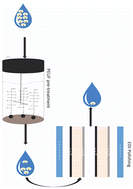Polymer-enhanced ultrafiltration–electrodeionization hybrid system for the removal of boron
Abstract
The consumption of ultrapure water (UPW) is continuously increasing owing to its numerous applications. In the production line of UPW using ion exchange resins, boron is usually found in the product water. Therefore, an optimized system is required for the efficient removal of boron. In this work, a hybrid system consisting of polymer-enhanced ultrafiltration (PEUF) and electrodeionization (EDI) was developed for boron removal from aqueous solutions. PEUF was used as a pretreatment step to reduce the boron concentration and thus improve the performance of the EDI system. In the pretreatment step, the polymer/boron ratio, the solution pH, and the contact time were optimized to achieve a boron removal rate of 68% by PEUF. The pretreated solution was then transferred to the EDI cell. During the EDI removal of boron, the removal rate was affected by the applied voltage and the flow rate but not by changes in the conductivity of the Na2SO4 solution in the electrode compartment. The optimum removal rate was achieved at an applied voltage of 30 V and a flow rate of 2 L h−1. Increasing the operating time from 3 to 10 h and the number of stacks in the EDI cell improved the removal rate to more than 99.9%. The results show that the PEUF–EDI system constitutes a promising approach to reduce the boron concentration in UPW.



 Please wait while we load your content...
Please wait while we load your content...